When it comes to DIY projects, there’s always the temptation to use what you already have on hand. However, when it comes to furniture renovations, the question often arises: Can you use wall paint on furniture? This comprehensive guide will delve into the possibilities and limitations of this approach, providing valuable insight into the world of furniture refinishing and repurposing.
In this guide, we will not only explore the intricacies of different paint types and their suitability for furniture, but also discuss the outcomes and alternatives to using wall paint. By considering factors such as durability, finish, and long-term performance, we’ll ensure that your furniture gets a makeover that not only looks fantastic but also stands the test of time.
Whether you’re a seasoned DIY enthusiast or just starting out, this guide will equip you with the knowledge and tips you need to make informed decisions about your furniture refinishing projects. Get ready to transform your furniture and create stunning pieces that reflect your personal style and creativity. Let’s dive into the wonderful world of furniture refinishing together!
Can You Use Interior Paint on Furniture?
Yes, you can use interior paint on furniture, but the outcome may vary based on several factors. Firstly, it depends on the type of paint you use and the specific material of the furniture. While interior paint is primarily designed for walls, which have different characteristics than furniture surfaces, with proper preparation and the right primer, you can achieve a successful furniture makeover using wall paint.
However, it’s important to consider that furniture is typically exposed to more wear and tear than walls. Therefore, in order to protect the paint and ensure its durability, it may be necessary to apply a clear sealant. This additional step can help safeguard the painted surface from potential damage.
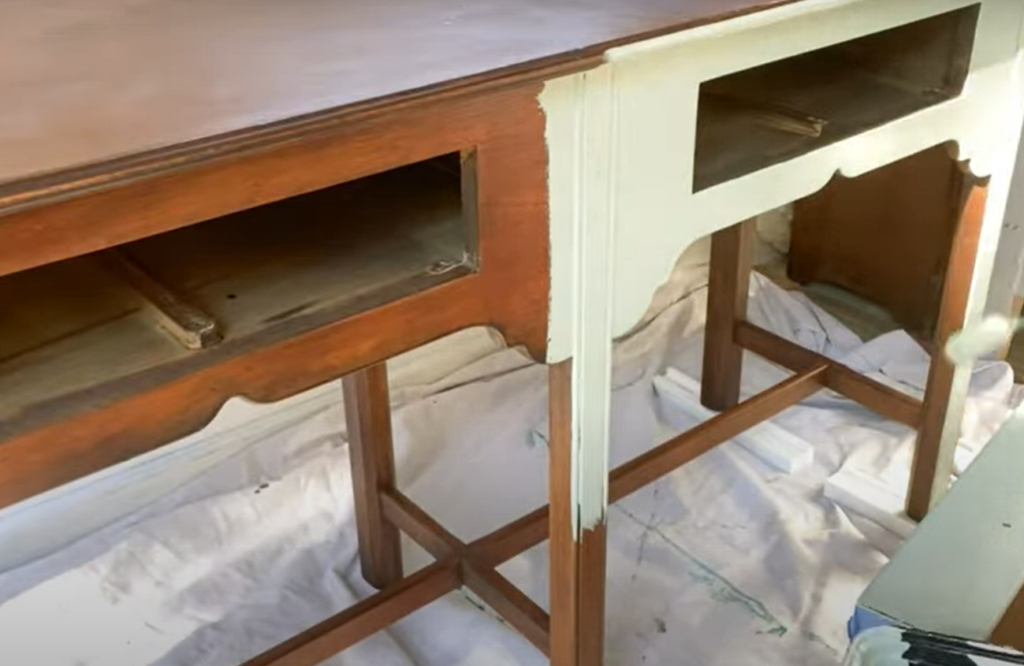
Furthermore, it’s worth noting that while interior paint can be used on furniture, it may not offer the same level of finish and durability as specialized furniture paint. Furniture paint is specifically formulated to withstand the demands of furniture use, providing a more suitable and long-lasting solution.
So, if you decide to use interior paint on your furniture, take into account the material, properly prepare the surface, use the correct primer, and consider applying a clear sealant for added protection. Alternatively, you might want to explore the option of using specialized furniture paint for optimal results in terms of finish and durability.[1]
What is Furniture Paint?
Furniture paint, specifically designed for use on furniture, is a type of paint that is typically more durable and has a richer finish than interior wall paint. It is formulated to adhere to various materials including wood, metal, and plastic with ease, reducing the need for extensive surface preparation. This specialized paint is carefully crafted to provide exceptional coverage and protection, ensuring that your furniture stays looking fresh and vibrant for years to come.
Moreover, furniture paint offers a longer-lasting finish, capable of withstanding regular usage, frequent cleaning, and the inevitable wear and tear that comes with everyday life. Its robust formulation creates a protective barrier that shields your furniture from scratches, stains, and fading, allowing it to maintain its beauty even in high-traffic areas.
While furniture paint can be slightly pricier than its interior counterpart, the investment often pays off in terms of the final result and the longevity of the refurbished item. The enhanced durability and superior finish provided by furniture paint make it a worthwhile choice for those looking to revitalize their furniture and create a lasting impact in their living spaces.[1]
What is Wall Paint?
Wall paint, often referred to as interior paint, is a versatile product specifically formulated to enhance the appearance of indoor walls and ceilings. Its primary purpose is to provide a smooth, even finish on large, flat surfaces, creating a visually pleasing and cohesive look for any space. With its wide range of available sheens, from matte to high gloss, wall paint offers flexibility in achieving the desired aesthetic.
Since walls are prone to accumulating dust, dirt, and marks over time, a durable and easy-to-clean paint is essential to maintain the overall appearance of a room. The water-based formulation of wall paint not only allows for effortless application and cleanup but also contributes to its lower toxicity compared to other types of paint, making it a safer choice for indoor environments.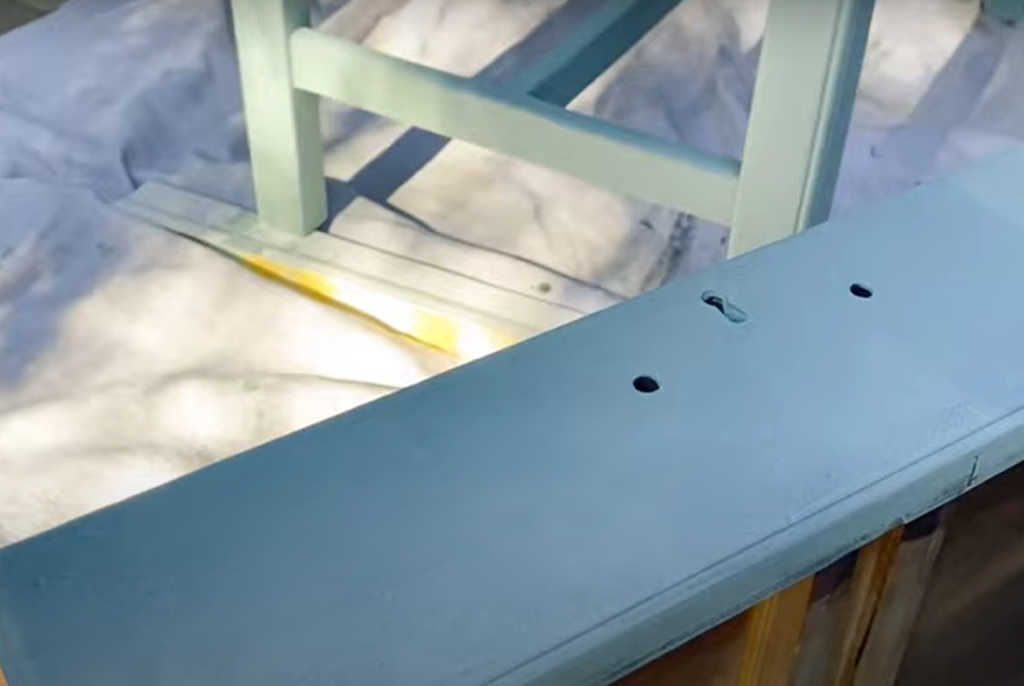
However, it is important to note that wall paint may not possess the same level of durability as furniture paint. Without proper surface preparation and the use of a suitable primer, it may not adhere well to certain materials or withstand heavy wear and tear. Therefore, it is recommended to consider the specific requirements of the surface and select the appropriate type of paint accordingly.
By understanding the unique characteristics and benefits of wall paint, you can make informed decisions when it comes to selecting the right product for your interior painting projects.[1]
Furniture Paint vs Wall Paint
When comparing furniture paint and wall paint, several important distinctions come to light. Furniture paint, which is specifically crafted for furniture surfaces, exhibits superior durability and adherence to various materials. This exceptional feature allows it to withstand the regular wear and tear that furniture often undergoes, ensuring a long-lasting finish that can withstand the test of time.
On the other hand, wall paint excels in providing an even and smooth finish on large flat surfaces like walls and ceilings. It is specially formulated to be resistant to staining and easy to clean, making it ideal for high-traffic areas. However, when it comes to furniture, wall paint may not adhere as well to certain materials and lacks the same level of durability as furniture paint.
Moreover, the sheen and finish level offered by furniture paint tend to be richer and more refined, enhancing the overall aesthetic appeal of the furniture piece. The carefully selected colors and finishes available in furniture paint can truly elevate the look of any furniture, adding a touch of elegance and sophistication.
While it is possible to use wall paint on furniture with proper preparation and priming, it’s important to note that the final result may not be as durable or visually pleasing as when using furniture paint. The unique formulation of furniture paint ensures that it can withstand the demands of everyday use, maintaining its beauty and integrity over time.
When deciding between furniture paint and wall paint for your DIY furniture renovation project, it is essential to carefully weigh these factors. Consider the specific needs of your furniture, the desired level of durability, and the aesthetic appeal you wish to achieve. By making an informed decision, you can ensure that your furniture renovation project is a success, resulting in beautifully transformed pieces that stand the test of time.[2]
Using Wall Paint on Furniture
If you decide to use wall paint on your furniture, preparation is key. Begin by sanding the furniture with fine-grit sandpaper to gently roughen the surface, creating a better texture for paint adhesion. Take your time and ensure that all areas are evenly sanded.
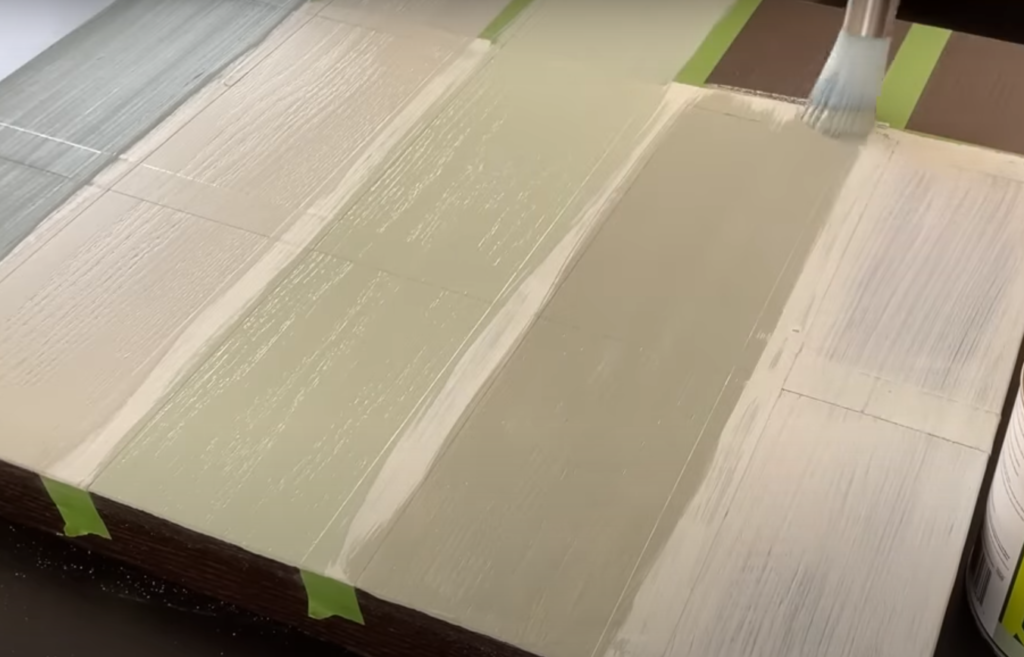
Once the sanding is complete, wipe down the furniture with a damp cloth to remove any dust or debris. This step is crucial to achieve a smooth and clean surface before painting.
Next, apply a high-quality primer as an undercoat. The primer will not only help the paint adhere better but also provide a solid base for the wall paint. Allow the primer to dry completely according to the manufacturer’s instructions.
When choosing your wall paint, opt for a semi-gloss or gloss finish. These finishes are not only easier to clean but also more resistant to wear and tear compared to matte finishes. Consider selecting a paint color that complements your existing decor or adds a pop of personality to your furniture.
When applying the paint, aim for thin and even layers. This technique will help prevent drips and brush marks, resulting in a professional-looking finish. Allow each coat to dry thoroughly before applying the next one. Patience is key here to ensure the paint cures properly.
To add an extra layer of protection and durability, consider applying a clear sealant once the paint has dried completely. This step will help guard against scratches and other potential damage, extending the lifespan of your painted furniture.
It’s important to note that while using wall paint on furniture can yield satisfactory results with proper preparation, it may not provide the same level of durability and richness of finish as furniture paint specifically designed for this purpose. If you’re unsure about the outcome, it’s always a good idea to experiment on a small, inconspicuous area first to ensure you’re happy with the results before tackling the entire piece.
By following these steps and taking your time, you can transform your furniture with wall paint, creating a unique and personalized look that adds charm and character to your space.[2]
Step-by-Step Process
Clean the wood furniture
Before attempting any form of painting, it’s crucial to ensure that the wood furniture is thoroughly cleaned. Begin by gently wiping away any visible dust, dirt, or grime using a clean, slightly damp cloth. Take your time to reach into crevices and corners, ensuring no residue is left behind.
For stubborn stains or residue, you can create a mild cleaning solution by mixing a gentle detergent with warm water. Dip the cloth in the solution and gently scrub the affected areas, taking care not to saturate the wood. Once the stains are lifted, rinse away any soap residue thoroughly with a clean, wet cloth.
After cleaning, it’s important to allow the furniture to dry completely. You can place it in a well-ventilated area or use a fan to speed up the drying process. This step is essential as any lingering moisture can interfere with the adhesion of the paint, resulting in subpar results.
If your furniture piece has any old paint or varnish, consider using a chemical stripper before proceeding with the sanding process. It’s important to note that chemical strippers should be used with caution and in a well-ventilated area. Follow the instructions on the product carefully and always wear protective gloves.
Once the old finish has been removed, your furniture is ready for sanding and painting. Use sandpaper of appropriate grit to smooth the surface and create a suitable base for paint application. Take your time to sand evenly, paying attention to any rough spots or imperfections.
With the surface properly prepared, you can now apply your chosen paint or finish to transform your wood furniture into a stunning masterpiece. Remember to follow the instructions on the paint can for best results and allow sufficient drying time between coats.
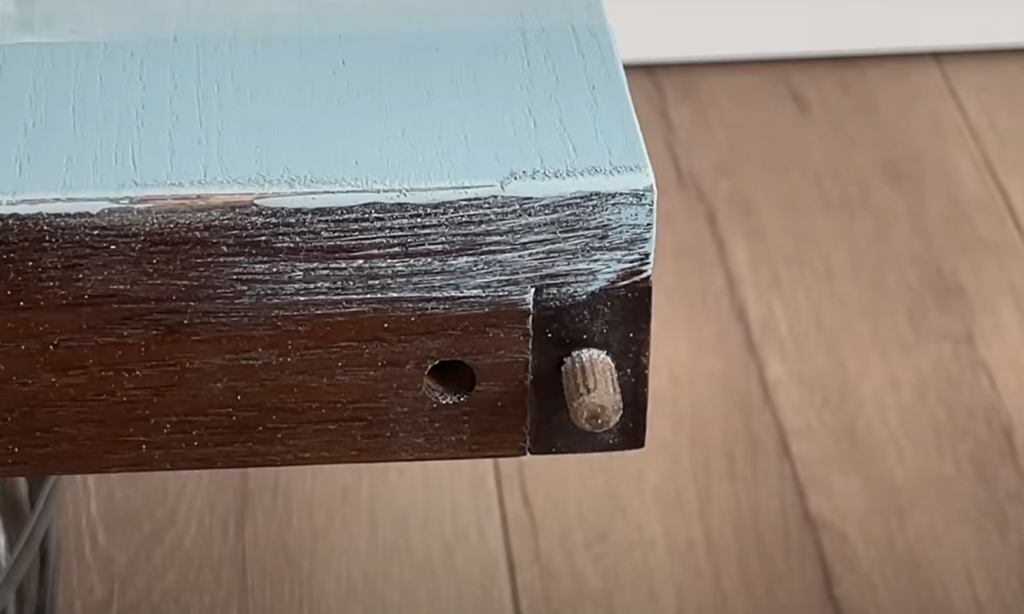
By taking these detailed steps, you can ensure that your painted wood furniture not only looks great but also maintains its beauty and durability for years to come.
Scrape off the old paint
After your furniture has completely dried from the cleaning process, the next step is to remove any existing paint. Depending on the thickness and type of the old paint, there are different methods you can utilize.
For smaller projects or where the paint is already peeling, a simple putty knife can be used to scrape off the loose paint. Ensure you work carefully to avoid gouging the wood. If the paint is particularly stubborn, you can also try using a gentle solvent or a paint stripper specifically designed for wood furniture.
For larger areas or thicker layers of paint, a paint scraper or a wire brush may be more effective. Always scrape in the direction of the wood grain to minimize potential damage to the furniture. Take your time and be patient, as removing paint from larger surfaces can be a time-consuming process.
In stubborn cases where the paint is not coming off easily, a heat gun can be used to soften the paint, making it easier to scrape off. However, exercise caution when using a heat gun, as excessive heat can damage the wood. Keep the heat gun moving and avoid concentrating heat in one area for too long.
Remember, safety should be your priority during this process.
Additionally, ensure proper ventilation in the workspace to prevent the buildup of fumes from solvents or paint strippers.Dispose of the scraped-off paint responsibly, following the regulations in your area for hazardous waste disposal. Once you’ve removed as much of the old paint as possible, your furniture is ready for the next step: sanding. Sanding will help smoothen the surface and prepare it for the application of new paint or finish.
By following these steps and paying attention to the details, you can effectively remove old paint from your furniture and create a clean canvas for your desired refinishing project.
Sand it
Sanding is an essential step in preparing your furniture for painting. It helps to smooth the surface and allows for better adhesion of the paint. Begin by choosing the right grade of sandpaper. For rough surfaces with old paint or varnish, start with a coarse-grit sandpaper (60 to 80 grit). Make sure to sand along the grain of the wood to avoid scratches. Once the old finish has been removed, switch to medium-grit sandpaper (100 to 150 grit) to smooth the surface further. Finally, use a fine-grit sandpaper (180 to 220 grit) for the final sanding pass to achieve a smooth, paint-ready surface. Remember to wipe the surface down with a damp cloth after each sanding session to remove dust and debris. This will ensure a clean surface for the primer and paint to adhere to, resulting in a smoother and more professional-looking finish. Always use safety goggles and a dust mask while sanding to protect your eyes and lungs from airborne particles.
Cover any cracks with wood putty
If your furniture piece has any cracks, holes, or gouges, it’s crucial to fill them in before painting. Wood putty, also known as wood filler, is perfect for this task. Start by choosing a putty that matches the color of your wood. Apply the putty to the affected areas using a putty knife, ensuring it’s spread evenly and smoothly. For deeper imperfections, you may need to apply multiple layers, allowing each one to dry before applying the next. Once you’ve filled all the cracks and holes, let the putty dry according to the manufacturer’s instructions.
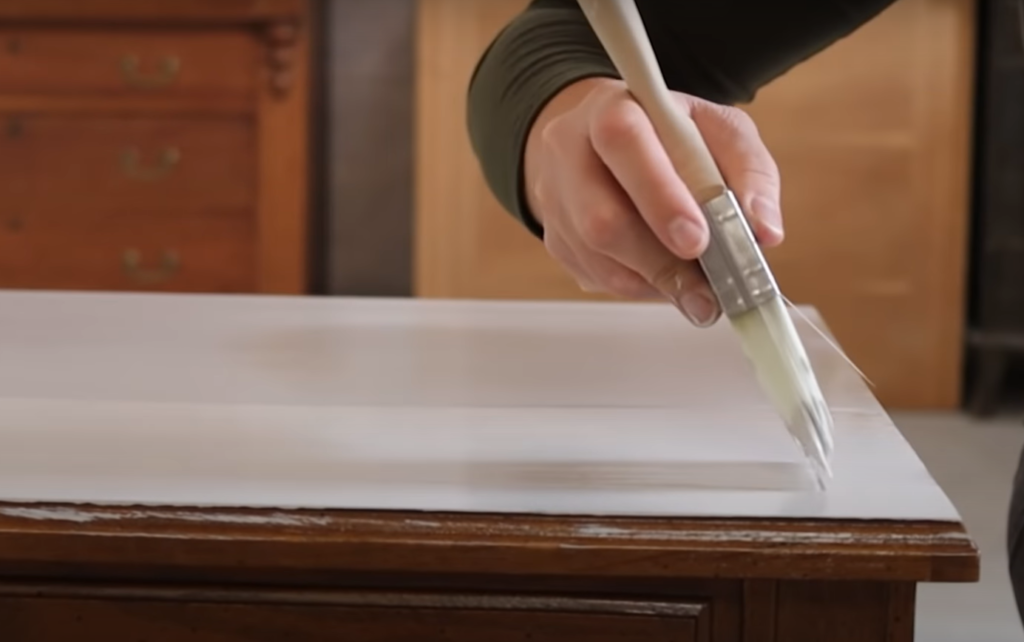
After it’s fully dried, sand down the filled areas with a fine-grit sandpaper until smooth and flush with the surrounding wood surface. Wipe away any dust with a damp cloth before moving on to the priming stage. By taking the time to properly repair any damage, you’ll ensure a smoother and more professional paint finish.
Sand the wood again
After sealing any cracks with wood putty and allowing it to dry, it’s necessary to sand the furniture again lightly. This is to ensure the smoothest possible surface for the primer and paint. Use a fine-grit sandpaper (220 to 240 grit) for this stage. Remember to sand in the direction of the wood grain for the best results. This gentle sanding will help remove any raised grain or minor imperfections left over from the putty application. It will also further prepare the furniture surface by creating tiny crevices, which allow the paint to bond better with the wood. After sanding, wipe down the furniture with a damp cloth to remove any dust or debris. Ensure the furniture is completely dry before moving on to the next step: applying the primer. As always, don’t forget to wear your safety goggles and dust mask during this process to protect your eyes and lungs from fine particles.
Scrape off the old paint
Primer is a coating applied to wood before painting to improve paint adhesion, durability, and protection. It is crucial when painting over dark colors or raw wood. Choose a suitable primer (oil or water-based) and apply it evenly with a brush or roller. Allow ample drying time based on the brand, temperature, and humidity. Lightly sand the surface with fine-grit sandpaper for a smooth base. Wipe off dust with a damp cloth before painting. Use safety gear like gloves and goggles when applying primer.
Apply the first coat of paint using a brush or roller
It’s time for the transformative part: applying the first coat of paint. Choose a high-quality paint for your preferred finish (matte, semi-gloss, or high gloss). Stir the paint thoroughly for even color distribution. Apply thin, even strokes following the wood grain direction. A roller works well for large surfaces, while a brush is better for detail. Avoid overloading to prevent drips. Let the first coat dry completely. Ventilate the area and use a respirator for safety. Once dry, it’s time for the second coat.
Lightly sand before the next coat
After the first coat of paint has thoroughly dried, it’s time to lightly sand the furniture before applying the second coat. This step is crucial for achieving a smooth, professional finish.
This process will help to smooth out any brush strokes or imperfections from the first coat of paint and will also promote better adhesion of the second coat. Remember to wipe down the furniture with a damp cloth after sanding to remove any dust or debris. Ensure the furniture is completely dry before proceeding to the next step: applying the second coat of paint. As with all tasks involving sanding, ensure you have appropriate safety gear on, namely safety goggles and a dust mask, to keep yourself protected from fine particles.Apply additional coats, sanding between them
To achieve the desired color and finish, multiple coats of paint may be necessary. Sanding between coats helps smooth imperfections and improve adhesion.
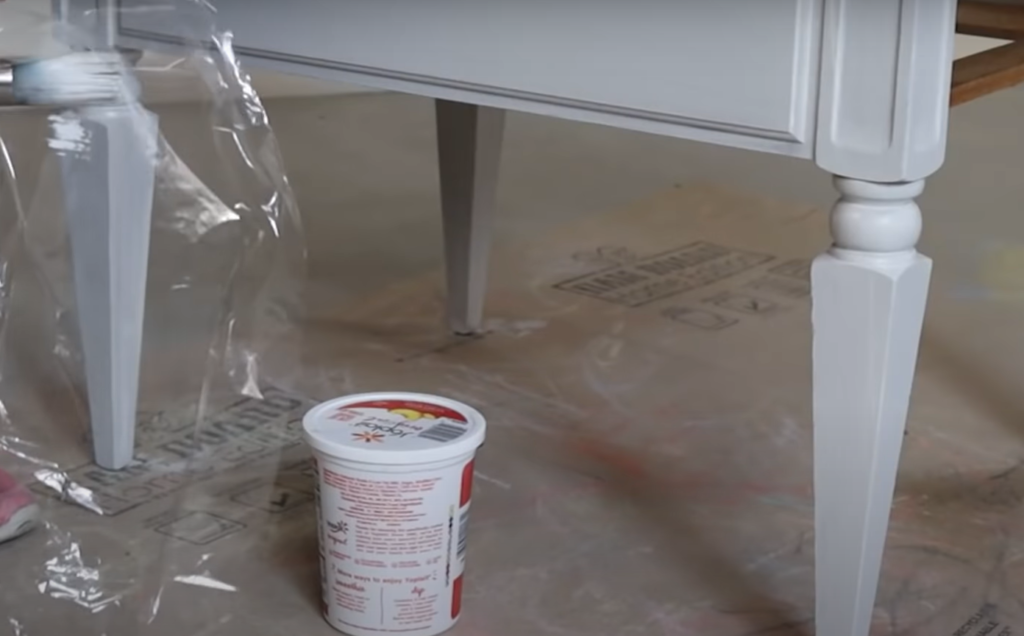
After wiping away dust, apply paint in thin, even strokes following the wood grain. Allow each coat to dry completely. Repeat the process until the desired color and finish are achieved, prioritizing safety throughout.[3]
Can You Use any Paint to Paint Wood Furniture?
When painting wood furniture, it is best to use paints specifically designed for furniture. Options like chalk paint, milk paint, and furniture-specific latex paint offer better adhesion, durability, and finish. However, with proper preparation, other paints like wall paint can also be used. Consider the desired finish (matte, semi-gloss, or high gloss) when choosing paint. Patience and preparation are key for a successful project, so follow manufacturer instructions and prep the furniture properly.[4]
FAQ
Can you use regular wall paint on wood furniture?
While it is possible to use regular wall paint on wood furniture, it may not be the ideal choice. Wall paint is thinner and less durable compared to furniture paint. However, with proper preparation, including sanding, cleaning, priming, and applying a protective topcoat, you can achieve satisfactory results. Just remember to consider the desired finish and follow the manufacturer’s instructions for the best outcome.
Can I paint furniture with interior wall paint?
Interior wall paint can be used to paint furniture, but there are some considerations. Wall paint is thinner and may require more coats for desired opacity. Its durability on furniture may be lower, but steps like sanding, priming, and applying a protective topcoat can help improve effectiveness. Follow instructions on paint and topcoat containers for best results.
Can I use leftover wall paint on furniture?
Using leftover wall paint on furniture is possible, but there are important considerations. Wall paint is thinner and less durable, so multiple coats may be needed for the desired color and it may not withstand heavy use. However, with proper furniture preparation such as sanding, cleaning, priming, and applying a protective topcoat, good results can be achieved. Patience and following instructions are key for the best outcome.
What’s the difference between wall paint and furniture paint?
Wall paint and furniture paint have distinct differences in composition, application, and finish. Wall paint is thinner and designed for large surfaces, while furniture paint is thicker and ideal for frequently used items.
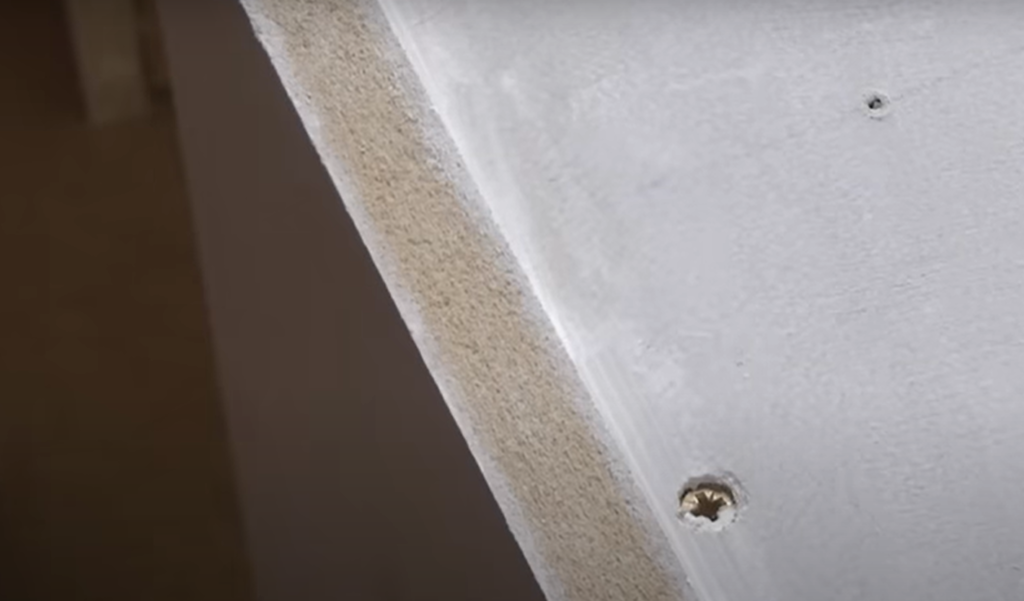
Furniture paint offers unique finishes and greater flexibility in achieving desired aesthetics. Both types require careful preparation for successful results.
Can you use wall paint on Ikea furniture?
When painting Ikea furniture, it’s important to prepare the laminate surface properly. Start by sanding lightly for better paint adhesion. Clean the furniture and apply a primer before using wall paint. Consider multiple coats for the desired color and finish, and apply a protective topcoat for durability. Follow instructions for a quality finish.
What happens if you use wall paint on wood?
Using wall paint on wood can yield varying results depending on factors such as wood type, condition, and application process. While wall paint can adhere to wood, it is typically thinner and less durable compared to paints specifically designed for wood. This may require multiple coats for desired color and opacity. Durability may be lower, especially for frequently used items or surfaces. Proper surface preparation, including cleaning, sanding, and priming, is crucial. Applying a protective topcoat, like varnish or polyurethane, can enhance durability. Patience, preparation, and following instructions are key for a quality finish.
Useful Video: Can you paint furniture or cabinets with house paint? YES!🧐 BUT…only some brands will actually work
Conclusion
Using wall paint on furniture can yield satisfactory results if done correctly. While wall paint is generally thinner and less durable than furniture paint, proper surface preparation, including cleaning, sanding, and priming, can make a significant difference. Adding a protective topcoat like varnish or polyurethane enhances durability. This makes it a viable option for utilizing leftover wall paint or achieving a specific color or finish. Remember, patience and following instructions are crucial for a quality finish, regardless of the paint type used.
References:
- https://woodworkingclarity.com/can-you-paint-furniture-with-wall-paint/
- https://www.2thesunnyside.com/painting-furniture-different-types-of-paint-when-to-use-them/
- https://inspireddecorator.com/using-wall-paint-on-furniture/
- https://www.woodcraft.com/blog_entries/can-you-paint-furniture-with-wall-paint










Leave a Review